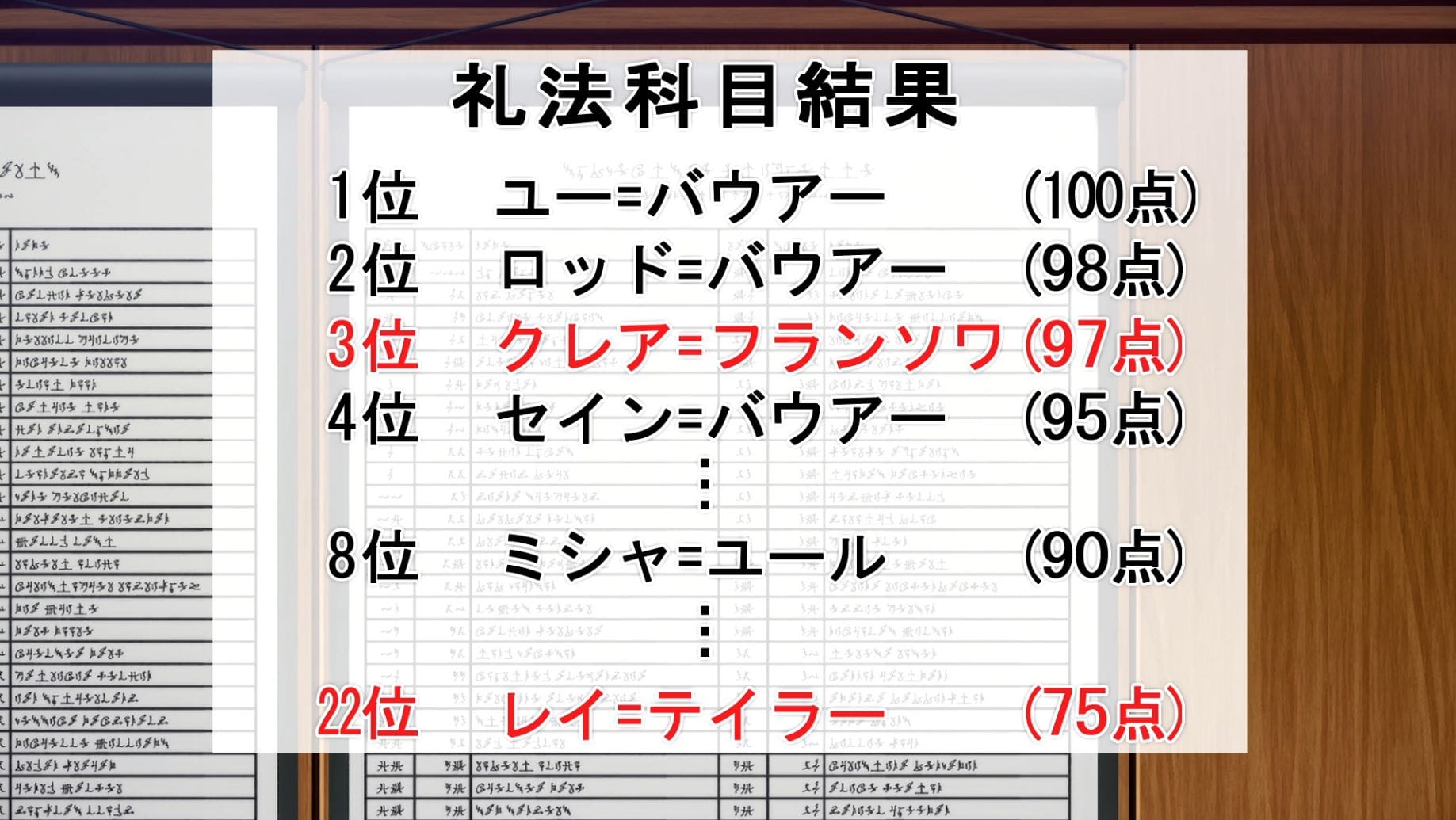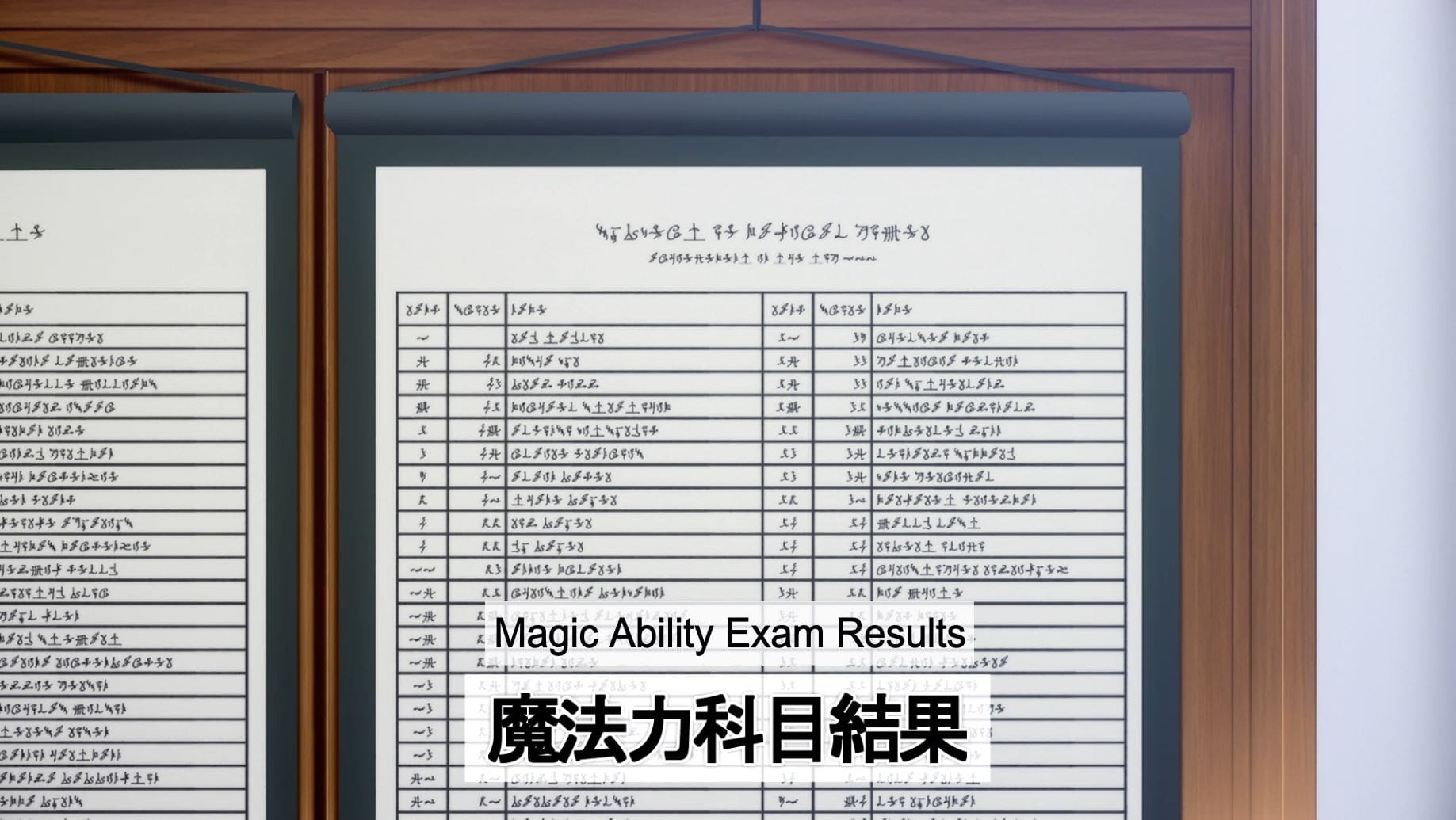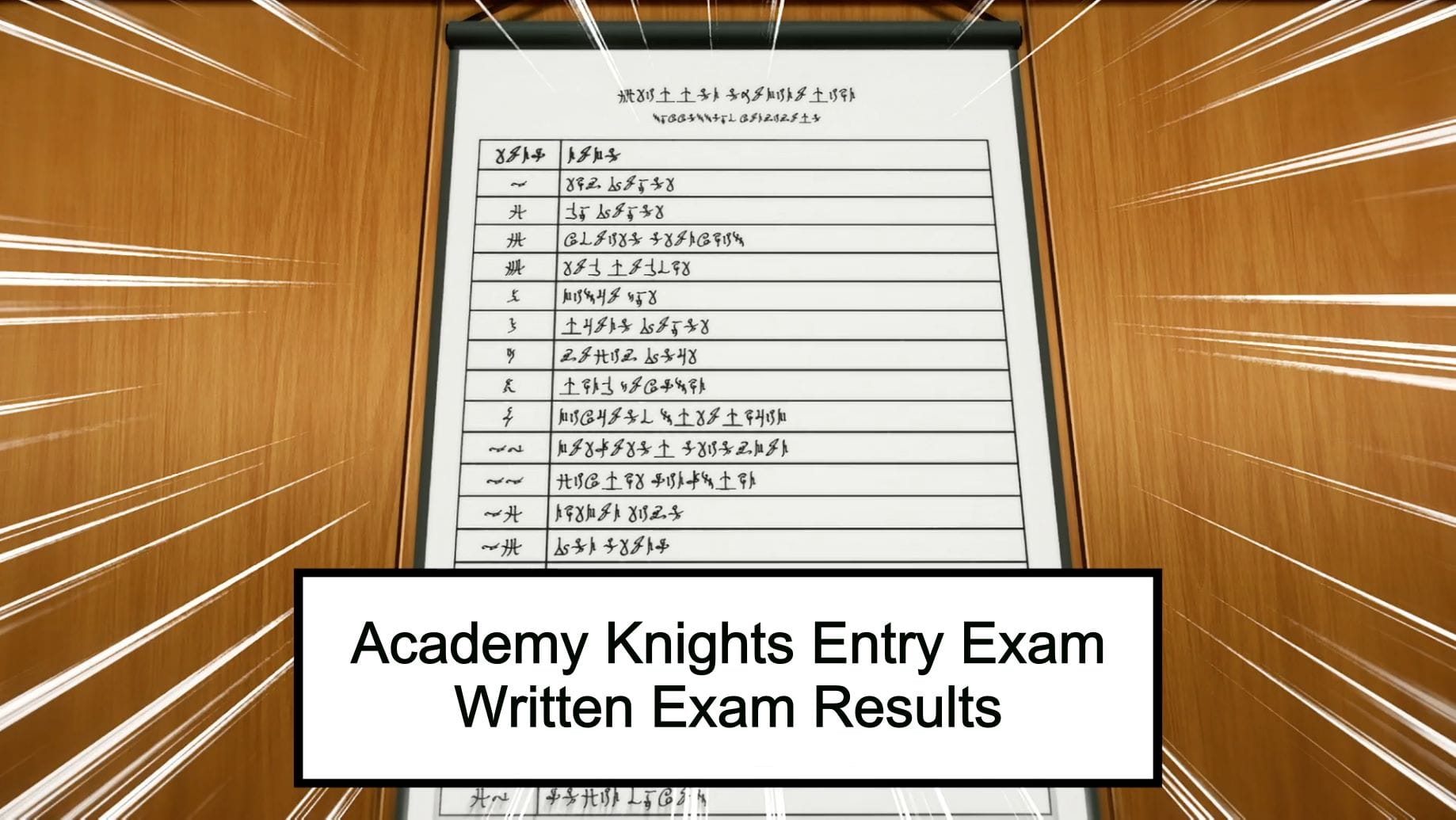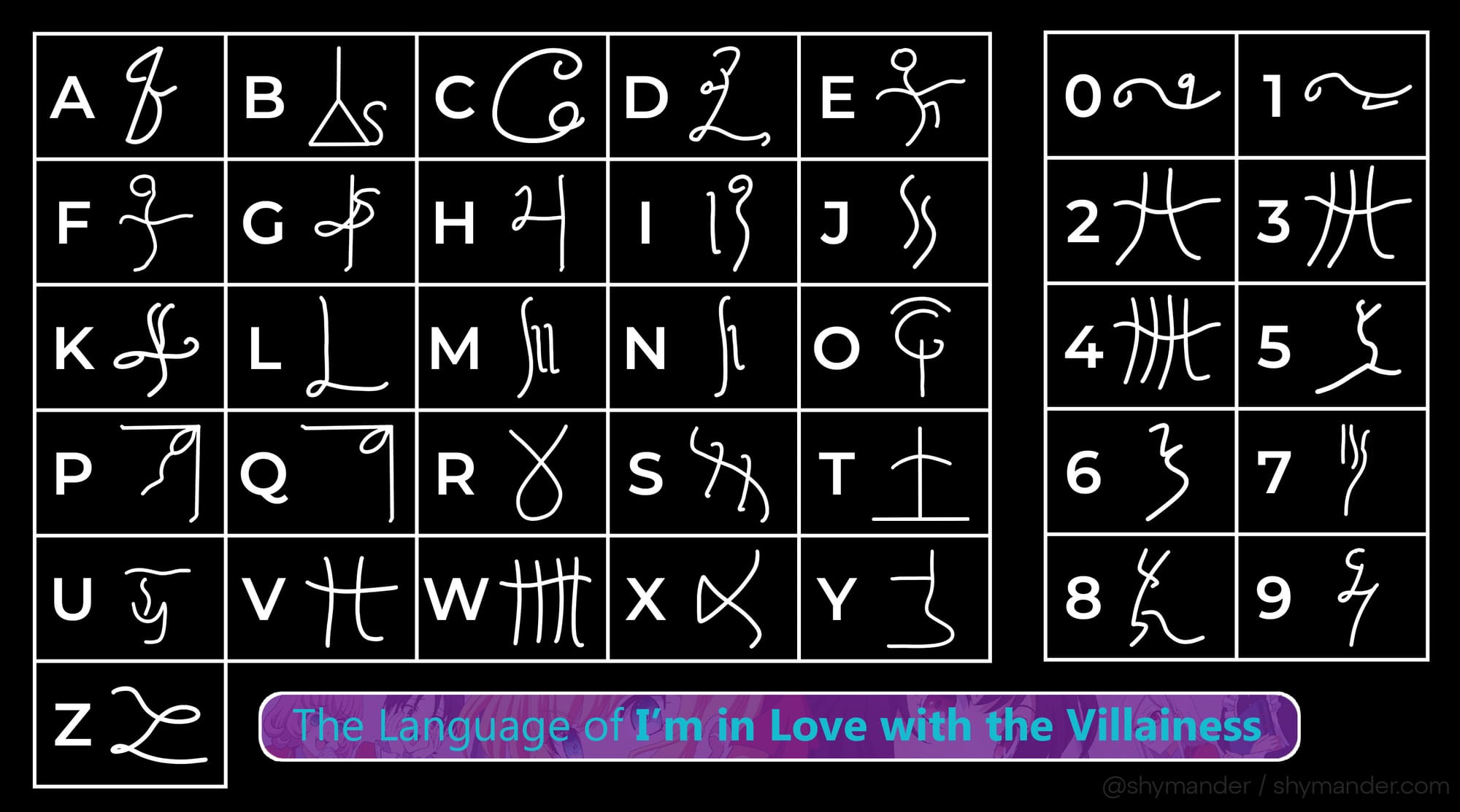How to Read the Language of I'm in Love with the Villainess

While Rae shows her appreciation for Miss Claire Francois by throwing herself into her arms and at her feet at every opportunity, I tend to show mine for anime by digging into the fun or unique details that make up their identity. This is usually exhibited through numbers, whether it be cataloging, census-taking or accounting, but a different kind of curiosity arose when I first watched the aforementioned pair butt heads over exam results: Is it possible to decipher the written language they’re using?
Scrawls, runes and similarly curly writing systems are a common background feature of fantasy anime, serving as subtle yet distinct worldbuilding on parchment, walls, magic circles, blackboards and so on. Some are simply strings of abstract symbols, while others, like those in Mushoku Tensei: Jobless Reincarnation, Ascendance of a Bookworm and To Your Eternity, have set rules and are entirely or partially interpretable, or are even openly taught to the viewer. Whichever method is used, it’s a remarkable attention to detail that always piques my interest as a student of language and fan of Denis Villeneuve’s Arrival.
So near the end of I’m in Love with the Villainess’ first episode, I couldn’t help but zoom in on the thoroughness of the below shot and notice some distinct patterns.

After comparing with the accompanying Japanese-to-English translation… I realized I had a Rosetta Stone on my hands.

The exam placements provide geographic coordinates for what’s what on the board, and the repetition of the name “Bauer” and its individual elements made the language’s base apparent: a simple one-to-one substitution with English characters and mapping out the above scene alone gives us 18/26 letters (A-F, H-J, L-O, R-U), as well as numerals 0-9.
That in itself was pretty exciting (I rushed to squee to my partner after), so the question then became how, and if, the remaining eight letters were present and translatable. The first thing I did was stay on the same frame and apply the identified characters to the board’s heading and subheadings, which roughly produces this:
Subjects of Eti_uette
Achie_ement in the to_ 100
Ran_ | Score | Name
It doesn’t take a genius or a Wheel of Fortune champion to deduce that the partial words in context are “Etiquette,” “Achievement,” “Top” and “Rank,” which together confirm half of the remaining letters: Q, V, P and K, leaving just an elusive G, W, X and Z. I could’ve continued by painfully writing out all the student names and seeing where that goes, but with a mostly complete reference guide in hand, I instead turned to the next set of results from Rae and Claire’s face-off.

Header translation? “Subject of Magical Po_er”. Bam, that gives us W.
It’s a few episodes before we get another clear instance of writing from there. It did, however, prove fruitful.

Written E_amination
Successful Candidate
Spot marks the X! That left just G, which one might think you’d come across by now, and Z, which was a little worrying. Thankfully, the next part of the Academy Knight testing saga delivered.

Kni_hthood Selection
Successful Applicant
Gee whiz, just like that, we have 25/26 letters deciphered and only Z to find. The lack of any other immediately discernible language samples in the series meant that some doubt crept in, but all I had to do was hopefully find a character in a previous screencap that didn’t match the others that had been identified. And for that, I have to thank one of the students tied for 45th place in the original “Subjects of Etiquette” exam: John Mackenzie.
The end result, if you can excuse my shoddy handwriting, is a comprehensive guide for reading and writing in the classy language of I’m in Love with the Villainess. Try testing yourself on the previous examples!

If we apply the grid to our Rosetta Stone, for example, we get this multicultural list of student names that is applaudably detailed to the point of including what seems to be multiple close sibling rivalries.
| Column 1 | Column 2 | Column 3 |
|---|---|---|
| Sunny Cleek | Yu Bauer | Linda Cooper |
| Calvin Gerbera | Rod Bauer | Karina Lawrence |
| Loran Falcon | Claire Francois | Michelle Williams |
| Merrill Philipe | Thane Bauer | Richard Isaac |
| Michele Millon | Alfonso Jitsuryok | Norman Rice |
| Eliot Moon | Max Ryan | Cindy Portman |
| Cathie Tone | Mena Young | John Mackenzie |
| Van Andalusia | Misha Jur | Ben Frank |
| Natalie Routh | Kevin Lucas | George Aquarius |
| Leonardo Summary | David Behr | Thomas Mackenzie |
| Jane Percival | Diana Shepherd | Hedwig Kelly |
| Margaret Friedman | Barbara Nelson | Dorothy Bloc |
| Willy Last | Brad Kidd | Paul Glen |
| Robert Olive | Ronaldo Maxwell | Mary Stewart |
| Christopher Rodriguez | Bob Johnson | Carina Rickenbacker |
| Mia White | Lewes Fender | Eddie Person |
| Mark Moore | Calvin Gerbera | Nicholas Wilson |
| Chelsea Mark | Tony Jackson | Teresa Rosen |
| Patricia Kelvin | Courtney Alexandria | Cannon Hartmann |
| Ian Sutherland | Maranne Alexandria | Amanda Babbington |
| Jessica Macdonald | Stephen Wirt | Emma Burns |
| Michelle Williams | Ra(y) Taylor | Billie Gohn |
| Bryan Graham | Robert Olive | Christina Benjamin |
| Henry Walker | Chelsea Mark | Alice Keaton |
| Douglas Lloyd | Sam Sanders | Daniel Huffman |
That’s my curiosity well satisfied, and now you, too, can immerse yourself further into the world of I’m in Love with the Villainess and the extra care that’s been put into it.